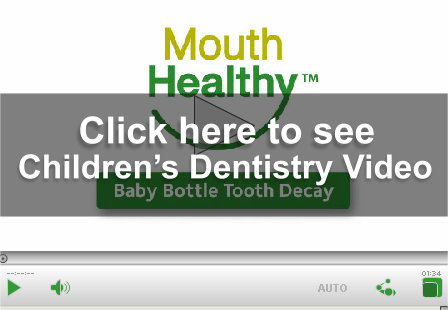Children’s Dentistry
A child’s primary teeth, sometimes called “baby teeth,” are as important as the permanent adult teeth.
When Do Baby Teeth Come In?
A baby’s 20 primary teeth are already present in the jaws at birth and typically begin to appear when a baby is between 6 months and 1 year.
When teeth first come in, some babies may have sore or tender gums. Gently rubbing your child’s gums with a clean finger, a small, cool spoon or a wet gauze pad can be soothing. You can also give the baby a clean teething ring to chew on. If your child is still cranky and in pain, consult your dentist or physician. Most children have a full set of 20 primary teeth by the time they are 3.
Why Baby Teeth Matter
Not only do primary teeth help children chew and speak, they also hold space in the jaws for permanent teeth that are growing under the gums. When a baby tooth is lost too early, the permanent teeth can drift into the empty space and make it difficult for other adult teeth to find room when they come in. This can make teeth crooked or crowded. That’s why starting infants off with good oral care can help protect their teeth for decades to come.
When Should I Start Taking My Child to the Dentist?
The ADA recommends that a dentist examine a child within six months after the first tooth comes in and no later than the first birthday. A dental visit at an early age is a “well-baby checkup” for the teeth. Besides checking for tooth decay and other problems, the dentist can show you how to clean the child’s teeth properly and how to evaluate any adverse habits such as thumbsucking.
How to Care for Your Child’s Teeth
It’s important to care for your baby’s teeth from the start. Here’s what to do:
- Begin cleaning your baby’s mouth during the first few days after birth by wiping the gums with a clean, moist gauze pad or washcloth. As soon as teeth appear, decay can occur. A baby’s front four teeth usually push through the gums at about 6 months of age, although some children don’t have their first tooth until 12 or 14 months.
- For children younger than 3 years, caregivers should begin brushing children’s teeth as soon as they begin to come into the mouth by using fluoride toothpaste in an amount no more than a smear or the size of a grain of rice. Brush teeth thoroughly twice per day (morning and night) or as directed by a dentist or physician. Supervise children’s brushing to ensure that they use of the appropriate amount of toothpaste.
- For children 3 to 6 years of age, use a pea-sized amount of fluoride toothpaste. Brush teeth thoroughly twice per day (morning and night) or as directed by a dentist or physician. Supervise children’s brushing and remind them not to swallow the toothpaste.
- For children 3 to 6 years of age, use a pea-sized amount of fluoride toothpaste. Brush teeth thoroughly twice per day (morning and night) or as directed by a dentist or physician. Supervise children’s brushing and remind them not to swallow the toothpaste.
If you have any questions concerning your Children’s Dental Care, give us a call. We will be glad to help.
Schedule Your Appointment
Thank you for choosing us to be your dental health care providers in Pawtucket. Following a good oral hygiene routine and receiving regular dental check ups are ways to keep your healthy smile.
